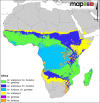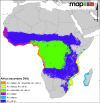A global map of dominant malaria vectors
- PMID: 22475528
- PMCID: PMC3349467
- DOI: 10.1186/1756-3305-5-69
A global map of dominant malaria vectors
Abstract
Background: Global maps, in particular those based on vector distributions, have long been used to help visualise the global extent of malaria. Few, however, have been created with the support of a comprehensive and extensive evidence-based approach.
Methods: Here we describe the generation of a global map of the dominant vector species (DVS) of malaria that makes use of predicted distribution maps for individual species or species complexes.
Results: Our global map highlights the spatial variability in the complexity of the vector situation. In Africa, An. gambiae, An. arabiensis and An. funestus are co-dominant across much of the continent, whereas in the Asian-Pacific region there is a highly complex situation with multi-species coexistence and variable species dominance.
Conclusions: The competence of the mapping methodology to accurately portray DVS distributions is discussed. The comprehensive and contemporary database of species-specific spatial occurrence (currently available on request) will be made directly available via the Malaria Atlas Project (MAP) website from early 2012.
Figures







References
-
- May JM. Map of the world distribution of malaria vectors. Geograph Review. 1951;41:638–639. doi: 10.2307/210709. - DOI
-
- Macdonald G. The epidemiology and control of malaria. London: Oxford University Press; 1957. Local features of malaria; pp. 63–99.
-
- Mouchet J, Carnevale P, Coosemans M, Julvez J, Manguin S, Richard-Lenoble D, Sircoulon J. Biodiversité du paludisme dans le monde. Montrouge, France: John Libbey Eurotext; 2004.
-
- Kiszewski A, Mellinger A, Spielman A, Malaney P, Sachs SE, Sachs J. A global index representing the stability of malaria transmission. Am J Trop Med Hyg. 2004;70:486–498. - PubMed
-
- Harbach RE. Genus ANOPHELES Meigen, 1818. Mosquito Taxonomic Inventory. Book Genus ANOPHELES Meigen, 1818 Mosquito Taxonomic Inventory City. 2011.
Publication types
MeSH terms
Grants and funding
LinkOut - more resources
Full Text Sources
Other Literature Sources
Medical
Molecular Biology Databases

